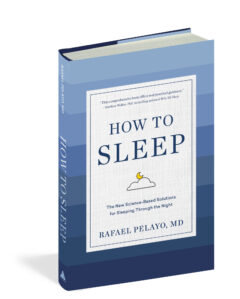Book Review: How to Sleep The New Science-Based Solutions for Sleeping Through the Night

FOR THOSE WHO NEED evidence-based convincing that rest is essential to wellbeing, the new book by Rafael Pelayo, MD, a sleep specialist at Stanford’s Sleep Medicine Center, offers plenty.
Pelayo praises naps, pointing out that “the idea of napping in the workplace is undergoing a cultural shift.” Some workplaces offer napping pods and nap rooms. “Sleep really is the ultimate form of self-care,” he writes.
He also points out that “the need for sleep is biological; the way we sleep is learned.” It’s no surprise that chronic sleep deprivation is rampant in today’s culture, though it’s also true that we don’t all need eight hours to feel rested.
He takes a mini detour into polyphasic sleep, which is when the sleep cycle breaks into two parts, with a period of unusually clear thinking and possibly even activity in between. It’s been said that some of history’s greatest thinkers received their breakthrough ideas in the middle of the night. Of course, 9-to-5 work hours have largely put an end to such a sleep schedule, but it’s good to know that if you do find yourself wide awake in the middle of the night, it might not necessarily be due to insomnia.
Other advice, much repeated, can be boiled down to: Don’t ignore the snore. Snoring among preschoolers is a predictor of attention deficit disorder, and sleep apnea can cause bedwetting—and that’s just scratching the surface. “If you hear someone snoring, let them know. You might be saving their life.”










